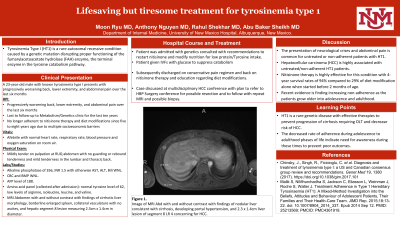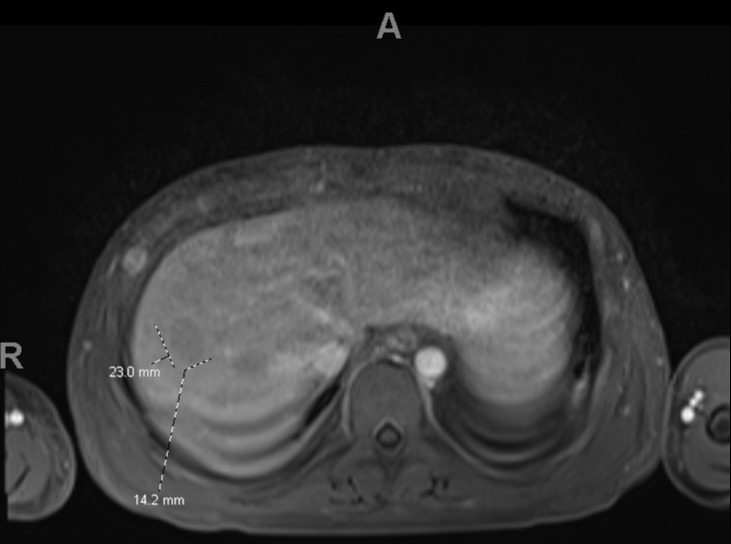Back


Poster Session B - Monday Morning
Category: Liver
B0608 - Lifesaving but Tiresome Treatment for Tyrosinemia Type 1
Monday, October 24, 2022
10:00 AM – 12:00 PM ET
Location: Crown Ballroom

Has Audio

Moon Ryu, MD
University of New Mexico Hospital
Albuquerque, NM
Presenting Author(s)
Moon Ryu, MD, Anthony Nguyen, MD, Rahul Shekhar, MD, Abu Baker Sheikh, MD
University of New Mexico Hospital, Albuquerque, NM
Introduction: Tyrosinemia type I (HT1) is a rare autosomal recessive condition caused by a genetic mutation disrupting proper functioning of the fumarylacetoacetate hydrolase (FAH) enzyme, the terminal enzyme in the tyrosine catabolism pathway. The below case exemplifies the difficulty for adherence as children transition to adulthood of the standard therapy that prolongs life and decreases need for orthotopic liver transplantation (OLT).
Case Description/Methods: A 23-year-old male with known tyrosinemia type I presents with progressively worsening back, lower extremity, and abdominal pain over the last six months. He had been lost to follow-up from Genetics clinic for the last ten years. He adhered to nitisinone therapy and diet modifications until around five years ago. The patient was admitted to the hospital for neurological crises due to non-adherence to HT1 therapy.
On admission, vital signs were stable and his physical exam significant for mild tenderness of abdomen at RUQ and tenderness in the lumbar and thoracic region of back.
Pertinent lab findings were albumin of 3.2, alkaline phosphatase of 356. AST, ALT, Bili, CBC, BMP WNL. Amino acid panel found tyrosine level of 62. AFP level of 188. MRI Abdomen with and without contrast found cirrhotic liver morphology, developing portal hypertension (borderline enlarged spleen, collateral vasculature, but no ascites), and a lesion of hepatic segment 8 measuring 2.3cm x 1.4cm in diameter. Patient was planned to be restarted on nitisinone with pending further evaluation of liver lesion.
Discussion: The above case demonstrates a patient with the rare genetic disorder Tyrosinemia type 1 with non-adherence to nitisinone and diet modification therapies. The presentation of neurological crises and abdominal pain with development of hepatomas/hepatocellular carcinoma (HCC) is typical for untreated or non-adherent patients with HT1. Nitisinone has been shown to be highly effective for this condition with 4-year survival rates of 94% compared to 29% of diet modification alone. Prior to nitisinone therapy, most patients required OLT. Despite the clear benefits, recent evidence is finding increasing non-adherence as patients grow older into adolescence and adulthood. This is consistent with adherence problems with early diagnosis chronic diseases with long-term therapies. More research is needed to elucidate major barriers for non-compliance and to refine guidelines regarding frequency of follow-up and monitoring of serum AFP to screen for HCC and encourage compliance.

Disclosures:
Moon Ryu, MD, Anthony Nguyen, MD, Rahul Shekhar, MD, Abu Baker Sheikh, MD. B0608 - Lifesaving but Tiresome Treatment for Tyrosinemia Type 1, ACG 2022 Annual Scientific Meeting Abstracts. Charlotte, NC: American College of Gastroenterology.
University of New Mexico Hospital, Albuquerque, NM
Introduction: Tyrosinemia type I (HT1) is a rare autosomal recessive condition caused by a genetic mutation disrupting proper functioning of the fumarylacetoacetate hydrolase (FAH) enzyme, the terminal enzyme in the tyrosine catabolism pathway. The below case exemplifies the difficulty for adherence as children transition to adulthood of the standard therapy that prolongs life and decreases need for orthotopic liver transplantation (OLT).
Case Description/Methods: A 23-year-old male with known tyrosinemia type I presents with progressively worsening back, lower extremity, and abdominal pain over the last six months. He had been lost to follow-up from Genetics clinic for the last ten years. He adhered to nitisinone therapy and diet modifications until around five years ago. The patient was admitted to the hospital for neurological crises due to non-adherence to HT1 therapy.
On admission, vital signs were stable and his physical exam significant for mild tenderness of abdomen at RUQ and tenderness in the lumbar and thoracic region of back.
Pertinent lab findings were albumin of 3.2, alkaline phosphatase of 356. AST, ALT, Bili, CBC, BMP WNL. Amino acid panel found tyrosine level of 62. AFP level of 188. MRI Abdomen with and without contrast found cirrhotic liver morphology, developing portal hypertension (borderline enlarged spleen, collateral vasculature, but no ascites), and a lesion of hepatic segment 8 measuring 2.3cm x 1.4cm in diameter. Patient was planned to be restarted on nitisinone with pending further evaluation of liver lesion.
Discussion: The above case demonstrates a patient with the rare genetic disorder Tyrosinemia type 1 with non-adherence to nitisinone and diet modification therapies. The presentation of neurological crises and abdominal pain with development of hepatomas/hepatocellular carcinoma (HCC) is typical for untreated or non-adherent patients with HT1. Nitisinone has been shown to be highly effective for this condition with 4-year survival rates of 94% compared to 29% of diet modification alone. Prior to nitisinone therapy, most patients required OLT. Despite the clear benefits, recent evidence is finding increasing non-adherence as patients grow older into adolescence and adulthood. This is consistent with adherence problems with early diagnosis chronic diseases with long-term therapies. More research is needed to elucidate major barriers for non-compliance and to refine guidelines regarding frequency of follow-up and monitoring of serum AFP to screen for HCC and encourage compliance.

Figure: MRI Abdomen with contrast with findings of a hepatic lesion on segment 8.
Disclosures:
Moon Ryu indicated no relevant financial relationships.
Anthony Nguyen indicated no relevant financial relationships.
Rahul Shekhar indicated no relevant financial relationships.
Abu Baker Sheikh indicated no relevant financial relationships.
Moon Ryu, MD, Anthony Nguyen, MD, Rahul Shekhar, MD, Abu Baker Sheikh, MD. B0608 - Lifesaving but Tiresome Treatment for Tyrosinemia Type 1, ACG 2022 Annual Scientific Meeting Abstracts. Charlotte, NC: American College of Gastroenterology.
